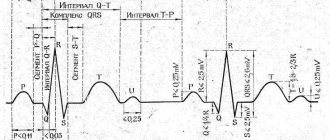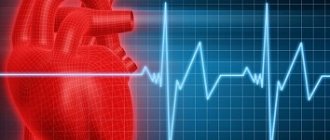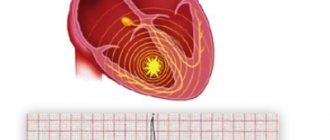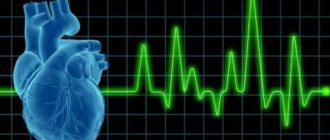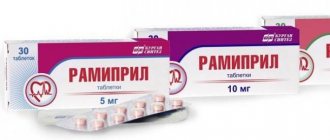Heart rate variability means its variability in response to physical, emotional stress and other external and internal factors. The closer it is to normal or slightly higher than average, the easier it is for the body to adapt to new conditions. High values occur in well-trained athletes who lead a healthy lifestyle, when a person receives sufficient loads and recovers well from them.
Low heart rate variability is typical for diseases: angina pectoris, myocardial infarction, diabetic polyneuropathy, changes in the heart muscle with high blood pressure (hypertrophic cardiomyopathy). A decrease in the indicator to critical values indicates the risk of sudden cardiac arrest.
An increase is a sign of the body’s readiness for stress and indicates the correctness of treatment for diseases. For the study, the rhythmography method is used (ECG for 5 minutes and loads or 24-hour monitoring, Apple Watch). Data assessment is carried out using mathematical analysis methods.
What is heart rate variability (HRV)
Pulse variability, or heart rate variability (HRV), is, in simple words, variety, that is, the acceleration and deceleration of contractions.
For example, a person's heart rate is 60 beats per minute. This means that one second passes between successive contractions. If there is variability, then one interval will be 0.8 seconds and the next 1.2 seconds. This is a simplified approach, but in reality both the pulse rate and the intervals between successive beats will change.
This is completely normal, because at rest the rhythm should become slower, but with physical and emotional stress it speeds up in order to improve the nutrition of internal organs and the brain. Heart rate variability is one of the adaptive reactions. Therefore, the faster the heart changes rhythm, the better a person is adapted to survive in a wide variety of environmental conditions.
For example, in well-trained and endurance athletes, the heart pumps slowly at rest, but during activity, a significant acceleration occurs very quickly. Likewise, after training, they need very little time to restore their original performance.
What does it mean if saved?
If heart rate variability is preserved, this means that the heart adequately responds to changes in the level of oxygen in the blood, an increase in the need for nutrients and energy.
Using an example, we can compare the normal reaction of a healthy, active young person and a heart patient. The first at rest will have an average heart rate of 65 beats per minute; at high load it will accelerate to 110-120. Then the heart muscle, brain, and skeletal muscles will receive a normal amount of oxygen to produce energy. At the end of the activity there is no need for a frequent rhythm; it will slow down and return to the original in 5-7 minutes.
With a slow pulse, the myocardium is well supplied with blood, and the strength of contractions increases. Heart rate variability in this case will be in the range of 65-115 beats.
A high resting heart rate is typical for heart patients. It is necessary in order to compensate for weak contractions of the myocardium and deliver as much oxygen as possible to the internal organs and the brain. Then the initial pulse will be 90-95 beats, and its increase to 110-115 may already be accompanied by heart pain and shortness of breath. Return to original values is slow. Patients feel palpitations for a long time after exercise. Heart rate variability is reduced, since the oscillation interval is only 90-115 beats per minute.
Application of HRV in medicine
The analysis itself is carried out by studying the sequence of cardiac intervals under different conditions:
- RR (contractile electrocardiogram)
- NN (spaces between normal heartbeats).
HRV of a healthy body
Studies in physically healthy individuals are carried out:
- When you need to determine whether a person is acceptable or unacceptable for training.
- Determine the athlete’s level and readiness to perform intense exercises.
- To prevent the development of pathologies.
How does HRV change in pathologies of the cardiovascular system:
Cardiac ischemia
In this case, there will be a decrease in the heart muscle rhythm variability, the rhythm will be stable, metabolic and humoral activity will be increased. The recovery period after an exercise test slows down sharply.
Myocardial infarction
When a heart attack occurs, the sympathetic nervous system begins to predominate, the electrical activity also appears inconsistent and HRV sharply decreases.
Heart failure.
There is a sharp decrease in HRV. The activity of the sympathetic nervous system is sharply increased. Because of this, tachycardia occurs and the blood level of catecholamines increases. There is no LF element in the spectrogram at all.
This often occurs when the disease becomes severe. In this case, there is a complete loss of sensitivity of the sinus node to impulses.
Hypertension
When the disease is in the first stage, a sharp increase in the spectral LF component is characteristic. When the disease moves to the second stage, this component, on the contrary, decreases its value. The rhythm of the heart is already affected only by the humoral factor.
Acute form of disturbances in the blood flow of the brain
At the same time, the HF element, which is controlled by the parasympathetic system, sharply decreases. There is a decrease in the variability of the heart muscle and the risk of complete cessation of myocardial tissue increases, and this leads to the death of internal organs and systems.
HRV decreases under the influence of emotional negativity, inadequate sleep, low physical fitness, and constant stress.
To increase the variability of the heart muscle, you need to limit yourself from unfavorable factors, adhere to a healthy lifestyle, and take vitamins on time. The HRV indicator is extremely important for diagnosis and choice of treatment tactics.
The use of different analysis methods makes it possible to obtain the necessary and accurate readings.
Why you need to know heart rate variability
Heart rate variability should be studied for the following purposes:
- assessment of the state of the autonomic nervous system and the balance between its two departments - sympathetic (conditionally stressful) and parasympathetic (responsible for recovery) in healthy people, with neurocirculatory dystonia, diabetes;
- check the body’s adaptive reserve, that is, the ability to work in extreme conditions (for example, a pilot);
- make a forecast of the risk of death in case of myocardial infarction, arrhythmia, heart failure, severe arterial hypertension;
- identify a risk group of patients who have the possibility of critical arrhythmia and need to have a pacemaker installed;
- select a drug or evaluate the effect of treating heart disease;
- determine the level of stress and stress resistance;
- identify the degree of maturity of the nervous system in children and adolescents.
Heart rate variability in sports is used to assess the initial state of the athlete, and then, during training, to determine the correct selection of loads and intervals between training for recovery.
Reduced HRV in diseases
Heart muscle variability decreases in diseases:
Myocardial infarction
With pathology, paleness of the skin appears, sweat appears, often cold, pain in the heart muscle of a pressing nature. Shortness of breath occurs, fainting may occur, and breathing becomes difficult.
Without urgent medical help, myocardial tissue infarction provokes the appearance of acute heart failure, rupture of the heart muscle, and a sharp decrease in HRV.
Multiple sclerosis
Pathology refers to chronic diseases of the nervous system. At the same time, the integral structure of the nerve fibers is disrupted. According to statistics, women are more likely to get sick. According to age indicators, it is often observed between the ages of 30 and 40 years.
When the disease occurs, a tingling sensation appears in the limbs, vision decreases, and there may be double vision. Urination problems often occur. In the first stages of sclerosis, excessive fatigue, low blood pressure, and dizziness occur.
Ischemic disease
IHD provokes a sharp deterioration in blood circulation in myocardial tissue. Shortness of breath, sudden changes in blood pressure, and acute pain in the chest occur.
Parkinson's disease
Pathology leads to the death of motor cells of the central nervous system. The patient begins to experience tremors, movements are constrained, and mental deviations occur.
Heart failure
In addition to a sharp deterioration in the variability of the heart muscle, the heart rate increases and the level of catecholamines increases.
Heart rate variability: normal
Heart rate variability is assessed using several parameters; their normal values for people of different ages (men and women) are given in the table.
| Age | RR during the day, ms | RR at night, ms | SDNN during the day, ms | SDNN at night, ms |
| 20-39 | 754 | 883 | 59 | 67 |
| 40-59 | 832 | 963 | 51 | 56 |
| 60-80 | 832 | 937 | 45 | 49 |
RR is the duration of the interval between beats, and SDNN is the standard deviation of the intervals between heart beats, that is, the total variability of the rhythm. Measurements are taken in milliseconds (ms).
Other indicators are also used, their generally accepted designations:
- LF: low frequencies in the range of 0.04-0.15 Hz;
- HF: high frequencies in the range of 0.15-0.4 Hz;
- RMSSD: sequential interval difference deviation, shows HRV at elevated heart rate.
These are not the only measurements; there are also several methods for processing indicators: time domain (statistical and geometric), frequency domain, nonlinear and mathematical modeling.
Apple Watch metrics and meaning
For healthy people, it is enough to measure only two main indicators - RR and SDNN. By changing their values, you can monitor the state of the heart and nervous system using the Apple Watch (smart watch). Measurements are taken 2 times a day, so for accuracy you need to wear the bracelet without taking it off. You can get a result sufficient for processing in no less than 10 days.
The readings are usually lower in the evening, and higher in the morning before waking up. HRV is influenced by many external and internal factors. Therefore, it is also important to determine your optimal indicator. To do this, it is recommended to record the SDNN value every morning, and then evaluate your well-being at the end of the day. In this way you can find the value at which there is a good state. Then you should start from your own norm.
Reasons for upward or downward changes
The following causes a decrease in heart rate variability in healthy people:
- fatigue;
- stress overexertion;
- lack of sleep and rest;
- smoking;
- alcohol abuse;
- excessive intensity and frequent training;
- colds;
- dehydration.
In diseases, a decrease in HRV indicates their progression. Normally, variability increases after rest, normalization of the daily routine, recovery, massage sessions, and relaxation. In athletes, HRV increases with adequate training. For patients, an increase can be achieved by strictly following the doctor’s recommendations for treatment, correcting habits and lifestyle.
What is the danger
The danger is a decrease in HRV in patients with heart diseases - angina, heart attack, myocardial changes with high blood pressure. This sign is regarded as:
- deterioration of the heart muscle;
- disease progression;
- limit of compensatory capabilities (for example, the heart cannot withstand a high load during hypertension);
- risk of death.
In an athlete, a decrease in heart rate variability reflects overtraining and deterioration in physical fitness.
Reduced heart rate variability: what does it mean, signs and symptoms
If rhythm variability is sharply reduced, this means that the heart muscle has exhausted its ability to compensate for high load or insufficient blood supply. The patient also has disturbances in the regulation of the rhythm of contractions on the part of the nervous and endocrine systems. The most studied signs of a drop in HRV are symptoms of angina pectoris, myocardial infarction, heart failure, and diabetic polyneuropathy.
Unstable angina
As HRV levels decrease in patients, the frequency and severity of attacks of chest pain increases. The ST segment drops on the ECG, reflecting deterioration of the coronary blood supply. With SDNN <40, the risk of sudden death within a month increases 8 times.
Myocardial infarction
A decrease in HRV reflects the depth and extent of the infarction and the severity of acute heart failure. The greater the increase in the tone of the sympathetic nervous system (increased heart rate), the higher the risk of a life-threatening form of arrhythmia - ventricular fibrillation with sudden cardiac arrest.
Heart failure
The higher the heart rate and the lower its variability, the more severe the circulatory failure. Patients experience shortness of breath and palpitations with lower levels of physical activity or even at rest. A drop in indicators reflects a decrease in the strength of myocardial contractions.
Diabetic polyneuropathy
With this complication of diabetes mellitus, a decrease in HRV makes it possible to detect deterioration in the innervation of the heart and other internal organs at a stage when there are no obvious symptoms. Typically, a slight change in indicators during an orthostatic test (transition to a standing position from a lying position). This means that the nervous system cannot provide an adequate change in heart rate during exercise.
How the heart and the vegetation system interact with each other
The central nervous system (CNS) consists of autonomic and somatic divisions. The autonomic system is autonomous and includes peripheral and central cell structures that provide regulatory properties for the body that are important for the full response of all systems.
The activity of the autonomic system occurs outside of human will. For example, you cannot make your heart beat faster or slower.
According to its anatomical characteristics, the autonomic system branches into the sympathetic and parasympathetic nerves. The sympathetic system helps increase the rhythm. It also regulates the functional activity of the ventricles of the heart muscle.
When breathing, differences in the rhythm of the heart muscles are also noticeable, and this is due to inhibition (which occurs on inhalation) and activation of the parasympathetic system (on exhalation). This means that the rate of contraction of the heart rhythm first increases and then decreases.
It has been established that the higher the HRV indicator, the better it is for the body. Parameters are considered high in healthy people and trained people. If HRV is sharply reduced, this can lead to mortality.
When the parasympathetic system is toned, this leads to an increase in HRV, and if the sympathetic nervous system is toned, this, on the contrary, reduces variability.
Indications for heart rate studies
Heart rate variability studies are needed when:
- attacks of chest pain;
- frequent fluctuations in pulse and blood pressure;
- signs of electrical instability of the myocardium - ventricular extrasystoles, complex arrhythmias with increased heart rate;
- the need to distinguish a functional rhythm disturbance (for example, in neurosis) from an organic one in heart disease;
- determining the stage of hypertension (from the second HRV decreases);
- assessing the risk of complications and poor prognosis in patients with cardiac pathology.
For healthy people, research is necessary when selecting a training regimen and professional selection for work with high stress on the body.
Mobile applications for HRV measurement
In practice, everyone who wants to take measurements at home has many options for this. Let's look at popular applications.
Elite HRV
An application for measuring heart rate variability, helps assess readiness for competitions.
The app displays a display of HRV, how breathing rates change, breathing guides, and how the body reacts to stress.
To activate and further use the application, a chest sensor is required. What measurements does the application show:
- Morning readiness. The measurement takes 2.5 minutes and must be measured daily in the morning. The indicator obtained in the morning is the most correct and shows the true state.
- Free metering. You can take measurements at any time of the day to assess the activity of the body.
This is what the final figure looks like:
- A green indicator indicates that today the body can withstand much more stress than at other times.
- Yellow represents the sympathetic system area and warns you that you are under more stress than usual. The recovery system is tense and has difficulty coping with the stress load.
- Red shows that you are stressed and in order not to overtrain, it is better to rest.
You need to pay attention to this and not overexert yourself during sports training. If you plan to exercise with the same intensity, then after physical activity there should be a rest for several days.
In order for the application to display the correct measurements, you need to enter data into it and you need to do this a few days before the measurement begins. Measurements need to be taken daily.
The app team has also released an educational HRV Course (in English only) for in-depth study of the topic.
Welltory
The application evaluates not only heart rate variability, but also determines how living standards affect physical condition.
The application displays the intervals between heart beats and shows the state of the body's autonomic system - energy reserves and stress level. Welltory is used in sports medicine and is available for smartphones.
You can find out your pulse, stress state and energy by placing your finger on the phone’s camera. The flash will record a video showing the heart rate and the time interval between contractions. Intervals reflect the work of the autonomic system.
It is recommended to take measurements daily. With regular measurements you will always know about the state of the body.
The application counts your heart rate and other data when you place your index finger on your smartphone's camera. Then, the app will display your stress level. Also, the application will help you correct your breathing technique. This will allow you to perform better in sports training.
The project team has also prepared many educational videos and materials on the topic of variability and stress management.
HRV4training (PRO)
The application measures heart rhythm, using not only the smartphone camera, but also Bluetooth chest sensors. Not only HRV is displayed, but also the oxygen saturation of the body. This is important for those who are involved in running sports, stress level, analysis of sports load on the body.
The application is suitable for professional teams, contains integration with sports applications and calendars, coach access and other advanced features.
Rules for rhythmography
Rhythmography requires strict adherence to the rules for ECG registration:
- time of day – from 9 am to 12 noon;
- temperature in the office – 20-22 degrees;
- complete silence;
- pre-ventilation for 30 minutes;
- semi-darkened room;
- absence of a health worker in the office during the recording period;
- lying or sitting position with support on the back of a chair;
- before starting recording, you need to give time to adapt (7-10 minutes);
- There should be no discomfort.
For women, days are chosen taking into account the menstrual cycle - usually 2-3 days after the end of bleeding and no later than 5 days before the next period.
Preparation for the procedure
The day before rhythmography, alcohol consumption, feasting, and night shifts are not recommended. You cannot take pills, drink coffee, play sports, or be nervous 12 hours before. Come for examination 2 hours after eating. In the office, you must turn off the phone and exclude all extraneous conversations.
Features of the study
After a short recording of the initial ECG (several cycles of 5 minutes), the doctor performs stress tests:
- respiratory - delay, acceleration, deceleration, long and short exhalation;
- change of body position - the patient is asked to stand up;
- squeezing the expander;
- vagal tests - massage near the carotid artery, eyeballs, cooling of the face, feet, hands;
- arithmetic exercises;
- taking medications that slow or speed up your heart rate.
Usually choose 2-4 types from those listed. When recording an ECG on a daily basis, the patient leads his usual lifestyle, but is required to record the time of sleep, meals, physical activity and its type, stress loads, and pain.
Decoding the results
After processing the results obtained, data is obtained on the functional state of the body; the decoding does not indicate the indicator of activity of regulatory systems (abbreviated PARS). It is considered a special program based on points. Taken into account:
- heart rate and variability;
- the ratio of sympathetic influences (stress, activity) and parasympathetic (rest, recovery);
- heart response to stress.
The points received are deciphered as follows:
- from 1 to 2 – the norm, the body reacts adequately to loads, the state of working (optimal) tension;
- from 3 to 4 – moderate tension of adaptive mechanisms, occurs during stress, transition to new working conditions, moving;
- 5 points – pronounced tension in the nervous and endocrine systems, but a healthy body can cope on its own, and in case of illness it is enough to reduce the effect of external factors;
- 6-7 points – overexertion, medicinal support of the body is required, complete exclusion of stress loads;
- 8-10 points – a critical failure of adaptation; a course of treatment will be required.
Rate variability is sharply reduced: how to treat
If there is a sharp decrease in heart rate variability, you must:
- reduction of load (reduction of physical activity, elimination of anxiety, conflicts);
- refusal of stressful changes (for example, change in climate, work, diet, business trip, participation in competitions);
- sleep at least 8 hours at night, if necessary, rest during the day;
- transition to a healthy diet - vegetables, fruits growing in the area of residence, lean meat, fish, dairy products, a minimum of processed and canned food, no spicy, fatty foods, alcohol, strong tea, coffee;
- provide an opportunity for relaxation for the nervous system - breathing exercises, walks in nature, light massage sessions, aromatherapy, listening to calm music.
If there are heart diseases, the doctor reviews treatment regimens; they can be supplemented with drugs that improve metabolism in the myocardium (for example, Preductal, Mildronate).
Increased variability: what to do
With increased heart rate variability, the body is ready for stress, so this period is considered optimal for any active exercise. Athletes with high performance demonstrate success in competitions; you can plan a change in climatic conditions (for example, a trip to hot countries on vacation or an expedition to the north). Any complex projects at such a time are considered especially successful.
Pulse variability means its variability when changing external and internal environmental conditions. If it is normal, then the body is well adapted to stress, and if it is reduced, rest and recuperation are needed. Low levels in heart patients are dangerous due to critical cardiac dysfunction.
Application of HRV in sports
It will be useful to use HRV when playing sports.
Variability shows:
- How is the recovery process going, are there any signs of overtraining.
- How prepared are you for sports activity?
- The likelihood of developing injury or illness.
Heart muscle variability can often be used to plan workouts, since monitoring stress and recovery levels will allow you to determine the degree of physical activity, depending on your condition.
With a normal or high HRV value (stress level is reduced) it will allow you to engage in intense training. If HRV is reduced, light training is recommended.
Studies have found that athletes with high HRV have significantly better oxygen consumption, while athletes with low HRV have worse oxygen consumption.
Conclusions:
- Low scores indicate incomplete recovery or accumulated stress.
- Indicators at rest do not correctly reflect the overtraining of the body, so it is necessary to measure it regularly.
- In the sport of running, variability is useless.
- Athletes with high HRV respond better to increased physical activity and experience better performance improvements.
- A training plan based on HRV data is more correct.
- Monitoring the dynamics of HRV can reveal an athlete’s predisposition to diseases.
This topic is considered relevant and especially important due to the growing popularity of using technologies for assessing variability in the process of training athletes. It is suitable for both cyclic sports and functional training, CrossFit, and training with weights at high heart rates.
To illustrate the application of technology in a sports environment, as part of a discussion club, a leading specialist at GeraklionMed talks about a number of features in HRV analysis in the following video.
At the conference, methods for long-term recording of HRV indicators (nightly and daily) were demonstrated for more effective monitoring of both the adaptive capabilities of athletes and reflecting recovery processes after high-intensity loads.
A special feature of the meeting was the unique practical information about the training process of highly qualified athletes from Valery Egorov (doctor of the Federal Sports Training System CyclON).
During the open discussion, comments were made about the recovery of the body after physical activity and about variability as such.
